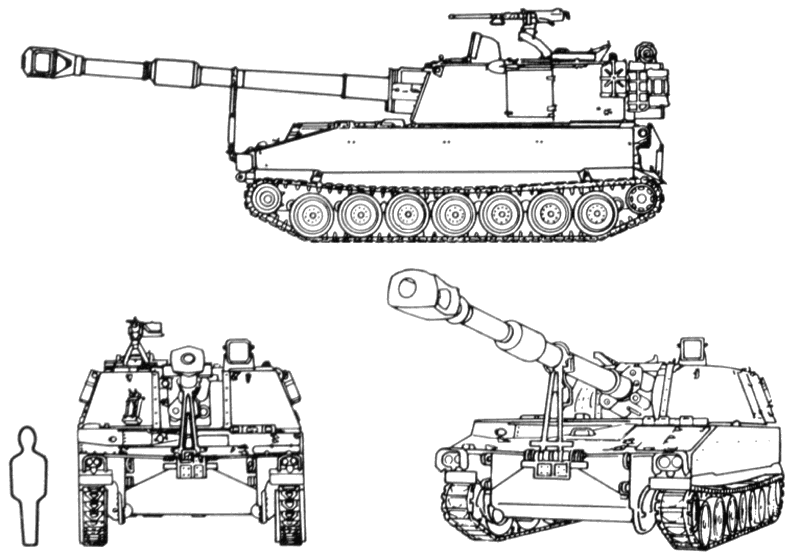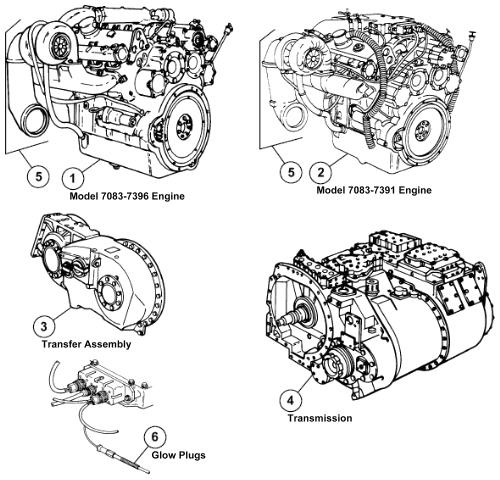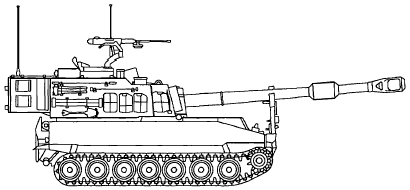The M109-series medium, self-propelled howitzer is a full-tracked, armored combat support, internally loaded, air transportable,
vehicle powered by an eight cylinder, diesel engine. The system is capable of both direct (line of sight) and indirect (out of
the line of sight) firing.
The hull and cab assemblies protect the crew and equipment against small arms fire. The vehicle is divided into three
sections: driver's compartment, engine compartment, and fighting compartment.
The
M992 Field Artillery Ammunition Support Vehicle (FAASV) is the companion vehicle to the M109 howitzer.
It serves as an area from which to service the weapon as well as a storage area for ammunition.
The powerplant can be removed from the vehicle as a complete unit that consists of an
engine Model 7083-7396 or LHR engine Model 7083-7391, transfer assembly, and transmission.
- Engine Model 7083-7396 is a liquid-cooled, two-stroke cycle, diesel-type, model 8V71T equipped with an exhaust-driven
turbocharger (5). The engine develops 405 horsepower at 2300 rpm and delivers power to the transfer assembly (3).
- LHR Engine Model 7083-7391 is a liquid-cooled, two-stroke cycle, low heat rejection, diesel-type, model 8V71T equipped
with an exhaust-driven turbocharger (5). The engine develops 440 horsepower at 2300 rpm, delivers power to the transfer assembly (3),
and uses glow plugs (6).
- The transfer assembly receives power from the engine (1 or 2) and transfers that power to the transmission (4).
- The transmission is oil cooled and mechanically and hydraulically operated. It receives power from the engine (1 or 2)
through a geared power transfer assembly (3). The transmission has seven gears - four forward, one neutral, and two reverse - and
delivers power to the left and right drive sprockets through the output shaft, universal joints, and final drives. It also functions
as the steering and braking mechanism.
The power pack in the M109A6 Paladin incorporates the new Low Heat Rejection (LHR) engine.
The LHR engine is less dependent on the cooling system.
This means that more of the engine's heat is rejected through the exhaust and less through the cooling system.
This is accomplished by insulating the exhaust ports and exhaust manifolds.
The new LHR engine also incorporates a new higher efficient turbocharger.
These changes provide a cooler running and more efficient engine.
Engine horsepower increase is also a by-product of these changes (440 horsepower at 2300 rpm).




 1993. The M109A6 Paladin howitzer is the latest product improvement to the original M109 155-millimeter self-propelled (SP) howitzer.
The Paladin features improvements in the areas of survivability; reliability, availability, and maintainability (RAM);
responsiveness; and terminal effects. Features include an on-board ballistic computer, secure communications, enhanced position and
navigation system, an integrated muzzle velocity system (MVS), new turret, improved cannon and mount, improved ballistic and nuclear,
chemical, and biological protection, automotive improvements, built-in test equipment (BITE), and driver's night vision capability.
1993. The M109A6 Paladin howitzer is the latest product improvement to the original M109 155-millimeter self-propelled (SP) howitzer.
The Paladin features improvements in the areas of survivability; reliability, availability, and maintainability (RAM);
responsiveness; and terminal effects. Features include an on-board ballistic computer, secure communications, enhanced position and
navigation system, an integrated muzzle velocity system (MVS), new turret, improved cannon and mount, improved ballistic and nuclear,
chemical, and biological protection, automotive improvements, built-in test equipment (BITE), and driver's night vision capability.